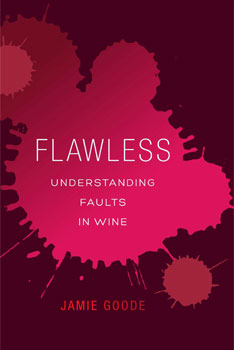

Flawless: Understanding Faults in Wine
Author: Jamie Goode
Publisher: UC Press, Oakland, CA; 2018
Price: $24.95
If you’ve ever spent time in a natural-wine bar, you may have wondered whether flaws in wine are an aesthetic judgment. Let’s say you like cabernet that tastes like cabernet, or Rioja that tastes like Rioja. Then you may have to taste through several oxidized, volatile or mousy wines before you find a drink to enjoy.
Consider, however, an observation Jamie Goode shares in Flawless, his latest book, focused on faults and taints in wine. When it comes to mousiness—a chemical taint that causes a wine to smell like a mouse cage—he points out that it’s only recognizable if the pH of your saliva is able to increase the pH of the wine sufficiently. “Is it always bad?” he asks in the “Mousiness” chapter. “Yes, although some people don’t find it offensive and can tolerate it better than others, and some can’t spot it at all.”
Perhaps the faults are not in our wines, but in our selves. Some of us just can’t tolerate a wine that smells like a pet’s cage or a nail salon. Or, at least, we tolerate wine faults differently.
The aesthetics surrounding perceptions of wine flaws fascinated Goode, as did the science, particularly in light of the work his co-chair for the International Wine Challenge, Sam Harrop, MW, was doing to assess and record all of the wines the judges deemed flawed. Goode and Harrop, co-authors of Authentic Wine in 2011, were considering a book on wine faults when they contributed an article to this magazine on how terroir expression is often conflated with wine faults (W&S Fall 2012). But with Harrop increasingly focused on winemaking projects, Goode set out to tackle the book on his own.
In it, he dives into 13 taints or faults, giving clear definition to words often bandied about at wineries and tastings, like reduction, oxidation, volatile acidity, ladybug taint and smoke taint. If you’ve ever wondered what each tastes like, how they come about and what growers, winemakers and wine drinkers are doing to avoid them, Goode’s book is essential reading.
It’s fascinating, too, as wine flaws reveal fault lines in our shared reality. When it comes to cork taint, for instance—a flaw caused by TCA (2,4,6-trichloroanisole, “formed in cork bark by the chemical combination of phenolic compounds with chlorine”)—we all have different thresholds for perception. I once tested my own on a visit with Phil Laffer, then chief winemaker at Orlando in Barossa, who led me through a tasting of 24 riesling samples, each inoculated with different levels of TCA. The taint was imperceptible in the first glass, and though there was no discernible mustiness as I worked my way up through the increments, there was an increasing sense that the wine had been stripped of its fruit clarity. It was only after reaching the threshold glass—often a different glass for each taster—that the musty character of TCA was apparent.
This variance in our ability to recognize and identify faults then raises a question: While it may be impossible for those of us who taste wine as part of our job—whether as winemakers, salespeople, shopkeepers, sommeliers or journalists—to enjoy a wine with even a low level of TCA taint, should we, when faced with a roomful of friends happily enjoying a wine we know is tainted, call it out? It’s a conundrum, just one of many that come to mind as Goode sets out to tackle the challenges of wine fl aws. The project is, by its nature, fraught. The author must guide the reader through circles of wine-tasting hell, each taint or fault a new assault on good taste. Meanwhile, he must also steer between the Scylla of science and the Charybdis of aesthetics, with plenty of opportunities to crash into his own perceptions.
For the most part, Goode is a terrific guide, but even as a scientist, he can’t completely avoid the prejudices of his own perceptions. He wrestles with those biases starting with the first chapter, “Brettanomyces.” In his introductory statements, the author had
already copped to the fact that he does occasional work for Lallemand, a company that markets cultured yeasts. Goode acknowledges the complexities of wine’s microbiological populations—and how they may contribute to the complexity, fascination and beauty we find in wines—but he often takes a pragmatic stance, here and in other chapters. In places, it seems his primary audience is the contemporary winemaking community, of which many, if not most, members have been trained to safeguard their fermentations with cultured yeasts, relying on their dominance and efficiency.
He does, however, raise complicated questions for the entire community of people who enjoy wine: Are some measurable “faults,” at levels below perceptible thresholds, crucial to the compelling scents and flavor depths we find in great wines? Is Brett more prevalent in some vineyards, raising the issue that microbial health in the soil and the vines might provide stronger resistance to rogue yeasts? As the author makes clear, some of the most coveted wines in the world make a strong argument that beauty has little to do with flawless juice. In the end, Goode leaves readers to consider their own perceptions and aesthetics when it comes to the unintended consequences of wine production. He provides valuable scientific perspective and thought-provoking details on wine faults and how they arise. And, while some portions of this book may seem too detailed and focused for anyone but a winemaker, there is perception-changing material here for any taster with an open or curious mind.
Joshua Greene is the editor and publisher of Wine & Spirits magazine.
This story appears in the print issue of February 2019.
Like what you read? Subscribe today.
















